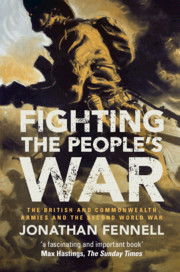Book contents
- Fighting the People’s War
- Armies of the Second World War
- Fighting the People’s War
- Copyright page
- Dedication
- Contents
- Illustrations
- Figures
- Maps
- Tables
- Acknowledgements
- Abbreviations
- Additional material
- Introduction
- Part I The Military and Political Context
- Part II The Great Crisis of Empire
- Part III Transformation
- 7 Victory in North Africa
- 8 New Guinea and Burma
- Part IV The Limits of Attrition
- Part V Redemption
- Part VI The Post-War World
- Conclusion
- Book part
- Notes
- Select Bibliography
- Index
7 - Victory in North Africa
from Part III - Transformation
Published online by Cambridge University Press: 21 January 2019
- Fighting the People’s War
- Armies of the Second World War
- Fighting the People’s War
- Copyright page
- Dedication
- Contents
- Illustrations
- Figures
- Maps
- Tables
- Acknowledgements
- Abbreviations
- Additional material
- Introduction
- Part I The Military and Political Context
- Part II The Great Crisis of Empire
- Part III Transformation
- 7 Victory in North Africa
- 8 New Guinea and Burma
- Part IV The Limits of Attrition
- Part V Redemption
- Part VI The Post-War World
- Conclusion
- Book part
- Notes
- Select Bibliography
- Index
Summary
By the end of July 1942, Churchill had lost faith in Auchinleck, his Commander-in-Chief (C-in-C) in the Middle East, who, at the time, was also commander of Eighth Army. On 13 August, after flying to Cairo to assess the situation for himself, he replaced Auchinleck with two men; General Bernard Law Montgomery was placed in charge of Eighth Army, and General Harold Alexander was appointed the new theatre commander.
Montgomery, whose whole career had been built towards this moment, would go on to become the most famous British general of the war (see Illustration 7.1). He had spent twelve years of his childhood in Tasmania before passing into Sandhurst in 1907, seventy-second out of 170. He passed out rather better, in thirty-sixth place, and was duly commissioned into the Royal Warwickshire Regiment. He spent four years in India before the outbreak of the First World War. Between 1914 and 1918, he was wounded three times (including a bullet through the lung), mentioned in dispatches six times and was awarded a DSO and the Croix de Guerre.
- Type
- Chapter
- Information
- Fighting the People's WarThe British and Commonwealth Armies and the Second World War, pp. 257 - 309Publisher: Cambridge University PressPrint publication year: 2019

